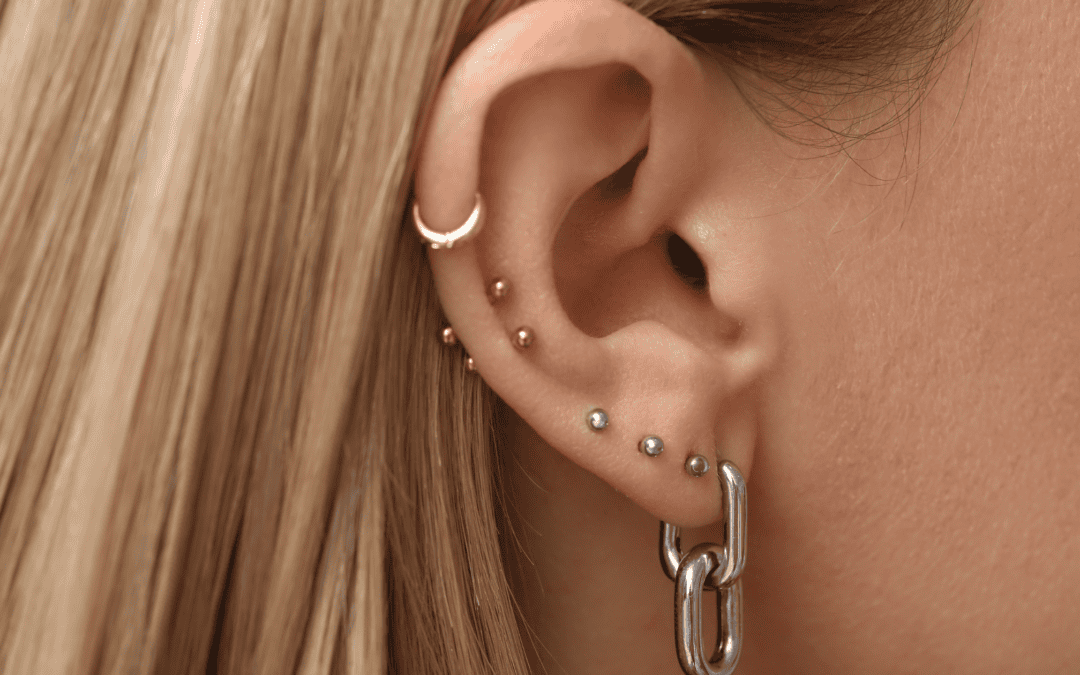Finding the Right Piercing Style, Placement, and Care
Getting your first piercing is an exciting milestone, but with so many options, it’s important to make a choice that aligns with your style, pain tolerance, and lifestyle. Whether you’re looking for a subtle addition or a bold statement, this guide will cover the essentials—from popular piercing types to aftercare tips—to help you make an informed choice for your first piercing.
1. Popular Piercing Options for Beginners
If you’re new to piercings, some placements and types are especially well-suited for beginners due to their popularity, versatility, and ease of healing.
Earlobe Piercing
Earlobe piercings are one of the most common and beginner-friendly options. They’re generally low-pain, heal relatively quickly (about 6-8 weeks), and allow you to try a wide range of jewelry styles. The earlobe is an excellent choice if you’re looking for a classic first piercing.
Helix Piercing
Located on the upper outer cartilage of the ear, a helix piercing is a popular choice for those wanting something unique but subtle. Helix piercings can be single or stacked for a more layered look. While cartilage piercings take longer to heal (up to 6-12 months), they’re relatively low-maintenance after the initial healing period.
Nostril Piercing
Nostril piercings offer a bold but adaptable option. Whether you choose a stud, hoop, or something more decorative, nostril piercings are visible and trendy. The healing time is moderate, usually around 4-6 months, and the pain level is generally tolerable.
Septum Piercing
The septum piercing, located in the area of the nose between the nostrils, has grown in popularity. This piercing offers flexibility since it can be hidden if you wear a small retainer. However, because it involves a sensitive area, the septum piercing can be more painful than other types.
2. Factors to Consider When Choosing Your First Piercing
There are several important factors to consider when selecting your first piercing, from pain levels to lifestyle considerations.
Pain Tolerance
Everyone’s pain tolerance differs, so it’s good to consider where you fall on the scale. Earlobe and nostril piercings tend to be lower on the pain scale, while piercings like the helix or septum might be more intense. However, for most people, the discomfort is brief and manageable.
Healing Time
Each piercing type has its own healing time, so it’s essential to understand how much care and time each one will need. Cartilage piercings like the helix or tragus generally take longer to heal than earlobe or nostril piercings. Be prepared for the commitment to daily cleaning and avoiding irritation during the healing period.
Lifestyle and Work Requirements
Think about how visible you want your piercing to be and whether it will be appropriate for your work or daily life. If you need a piercing that’s easy to hide, consider placements like the earlobe or septum, which can be discreetly tucked with a retainer.
3. Finding a Trustworthy Piercer

A qualified, experienced piercer will ensure your piercing is done safely and hygienically. Here’s how to find the right professional for the job:
Research Studios and Read Reviews
Look for a studio with excellent reviews and a reputation for cleanliness and professionalism. Customer feedback will give you an idea of the piercer’s experience and customer care.
Verify Licensing and Sanitation Practices
Make sure your piercer is licensed and follows all health and safety regulations. The studio should use sterilized equipment and disposable needles, and the piercer should wear gloves.
Ask Questions
Don’t hesitate to ask your piercer questions about the procedure, aftercare, and any concerns you might have. A professional piercer will be happy to provide information and ease any anxieties.
4. The Piercing Process: What to Expect
Understanding the piercing process can help you feel more prepared and relaxed. Here’s a quick overview of what typically happens during a piercing appointment:
- Consultation: You’ll discuss the placement, jewelry options, and care with your piercer.
- Preparation: The piercer will clean and mark the area to ensure precise placement.
- Piercing: The piercer performs the piercing using a sterilized needle, which takes only a few seconds.
- Jewelry Insertion: Your initial jewelry, usually a stud or hoop, is inserted to allow for swelling during healing.
- Aftercare Instructions: The piercer will provide instructions for cleaning and caring for your new piercing.
5. Essential Aftercare Tips for a Safe and Quick Recovery

Proper aftercare is crucial for preventing infections and ensuring your piercing heals well. Below are some standard aftercare guidelines to follow:
Cleaning
Clean the piercing site twice daily with a saline solution or an aftercare product recommended by your piercer. Avoid alcohol or hydrogen peroxide, which can irritate the skin and prolong healing.
Avoid Touching
Avoid touching or twisting the jewelry, as this can introduce bacteria and cause irritation. Only touch the piercing with clean hands if necessary for cleaning.
Protect the Piercing
Avoid sleeping directly on the piercing or wearing tight clothing that may rub against it. For facial piercings, avoid makeup around the area during the initial healing stages to reduce the risk of infection.
Watch for Complications
It’s normal for a new piercing to be slightly red and swollen, but consult your piercer or a healthcare professional if you notice excessive pain, pus, or prolonged swelling.
6. When to Change Your Piercing Jewelry
After the initial healing period, you may be eager to switch up your jewelry. However, changing jewelry too soon can irritate the piercing and even cause it to close up. Follow your piercer’s guidelines, which often include waiting at least the full healing period before swapping jewelry. Once the piercing is fully healed, you can explore different jewelry options to suit your style.
Making an Informed Choice for Your First Piercing
Choosing your first piercing is a personal journey that allows you to express yourself in a new and exciting way. By considering your pain tolerance, lifestyle, and healing commitment, you can pick a perfect piercing. With the right choice, a professional piercer, and proper aftercare, your first piercing experience can be safe and satisfying.




